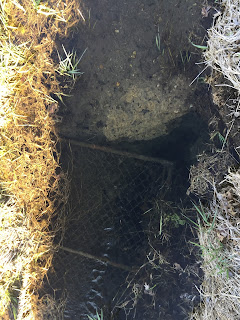I've always been fascinated by freshwater springs. They are real live fairy tales. I stare in wonder at the waters of the deep opening up. Where does all the water come from, and why does it emerge from dead earth exactly in this location? I'm unaware of the extent that this happens throughout the world, for PA is all that I really know.
One spring, in particular, is near and dear to my heart. After emerging approximately one mile upstream, Trout Run flows through my back yard. Our home is okay, but this is definitely why we moved here in 2006. The springs that form Trout Run are consistent. The supply of cold, clean water is almost exactly the same whether we are in the middle of April rains or August droughts. How could this be?
For fun, I thought to summarize a few nights of my amateur level research.
In the beginning was compression. Over nearly incomprehensible epochs, seashells, microskeletons, and sediments piled up, layer upon layer, with enough crushing force to create enormous limestone flats. This is the DNA of Trout Run, and the shared ancestry of all limestone springs of the Mid Atlantic.
Then came the collision. Tectonic plates bent and heaved, folded themselves as an accordion. And so the land was fashioned into a valley, which happens to be approximately 12-miles wide at this latitude. A hundred thousand years of shifting occurred. Rivers formed and eventually rerouted through the permeable limestone layers. A large underground river came to pass in the deep places of what we now call the Cumberland Valley.
To this day, there is crashing. The river travels through limestone layers, gradually decreasing in width, until running into an impermeable rock wall. The path of least resistance is then up, and water rises to the surface of the earth in "here and there" fashion. Fountains of life are poured forth as from the hands of angels.
Water miraculously ascends all over the valley, especially along the underground ridges of hard rock. To this day, Silver Springs, Trindle Springs, Bermudian Springs, Whiskey Springs, Boiling Springs, Mount Holly Springs, Big Spring and more, all bear witness to this nameless river and unseen rock wall.
For thousands of years, the springs supported a proliferation of wildlife and eventually people. Prehistoric natives would settle around the springs, connecting their establishments by a series of trails that tied the valley to the Susquehanna River.
Prehistoric native Americans gave rise to modern native Americans, and in some instances were replaced by them. Those native Americans were soon replaced by European settlers. Families that landed here gave rise to farms and communities centered on and around the freshwater springs, many of which stand to this day.
In typical white guy fashion, the native American trails were improved (depending on your perspective) and most of them renamed. Lisburn Road, Trindle Road, Old York Road, Carlisle Road, and so forth. These were originally native American trials between various springs which follow an unnamed underground river and rocky geological feature.
I laugh when considering the price of land for sale in proximity to the various roads and traffic patterns. The realtors call them "Prime Location," but probably don't realize this has been the case for many centuries.
Trout Run arises from a series of small springs between old Gettysburg Pike and Williams Grove Road. This year I had the chance to trace this stream to its origins before they are covered with plant overgrowth.
-There is one moderate sized spring near the old Aschomb mansion.
-A little further upstream from there is a large spring surrounded by a well built rock wall immediately next to Lisburn Road.
 |
| Trout Run wetlands/preserve |
-Approximately 50 feet upstream from that and behind a large red barn is a prominent spring covered by a privately owned and well maintained spring house.
-Approximately one eighth mile upstream from that is the Trout Run nature preserve. Trout Run is actually very small at this point, but in one area does widen into a shallow pond of sorts. Near the side of this pond and middle of the nature preserve is a series of very small springs.
 |
| A hole in the clay well is deep and so has a fence across it. |
 |
| THE birthplace of Trout Run |
-Approximately one eighth mile upstream from there is an unremarkable residential backyard with a very deep spring of water popping out from flat ground (image above).
-And finally, twenty or thirty feet upstream from there, at the lowest margin of the land owned by West Shore E-Free Church, directly under a small bridge on the walking path, is a small trickle of water, the VERY beginning of Trout Run.
In it's entirety, Trout Run travels approximately two miles before it feeds into the Yellow Breeches near the athletic fields at Messiah College. The famous Yellow Breeches is simply a gradual surface level reunion of a portion of the large underground river.
But Trout Run is also "the stream," a priceless treasure where we play and swim, catch frogs, water the chickens, and fish for native Brook trout. Trout Run is always a prominent feature in various backyard obstacle races. This is home.
May God help us to share and care for what has been granted us.


No comments:
Post a Comment